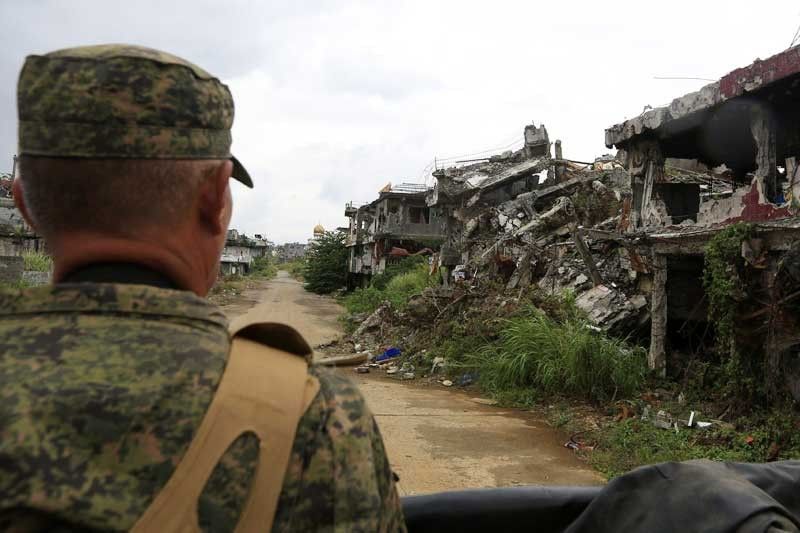Two years since the end of the Marawi siege: What's changed?

MANILA, Philippines — October 17, 2017 saw President Rodrigo Duterte declare the city of Marawi “liberated from the terrorist influence" after a battle that reduced what was once a bustling Islamic commercial center to rubble.
Today, exactly two years after the end of the siege, the city, along with the rest of Mindanao, lies suspended in martial law after having been extended thrice from 2017 to December 2019. It is expected to remain that way until the end of the year.
Meanwhile, many of the 370,000 internally displaced persons have not returned to their homes.
Martial law extensions
A firefight erupted on May 23, 2017 when Filipino security forces carried out a raid to arrest Isnilon Hapilon, a leader of the ISIS-affiliated Abu Sayyaf. Shortly after, members of radical Islamist organization Maute were called in for reinforcements.
The next five months left around 160 soldiers and 1,000 terrorists dead in their wake, as the first wave of military rule was declared immediately after the breakout of the siege.
Duterte's 2019 midterm report said that although the Lanao del Sur provincial capital was successfully liberated in October, "the threat of other rebel and terror groups remained." For Malacañang, this justified the continuation of the military government in the area.
Duterte in July also expressed willingness to extend martial law once more, saying, “If the local government unit, the governors, mayors and even the congressmen would find that it could be in the best interest of the Filipinos in Mindanao, I would not hesitate to say yes.”
In the aftermath of the former economic hub’s siege, the damage was estimated by the Asian Development Bank to be at P11.5 billion, although a Task Force Bangon Marawi post-conflict needs assessment team placed the value much higher at P18.6 billion.
Rehabilitation and recovery efforts
Due to a number of postponements, it took over a year for the TFBM to finally begin groundbreaking for the rehabilitation of Ground Zero in October 2018.
The Philippines Humanitarian Country Team in its 2019 Marawi Humanitarian Response, Early Recovery and Resources Overview estimated that some 230,250 people have returned to the 72 barangays in the city. Meanwhile, a March 2019 newsletter by the National Housing Authority claimed that they along with TFBM provided 550 transitional shelters to the Marawi City LGU for the remaining IDPs.
Despite all this, the city still remains in ruins: shuttered and unpeopled.
Both the HCT report and the IDMC’s 2019 Global Report on Internal Displacement admit that as of March 2019, some 73,000 people and almost 2,000 families are still displaced and living in 21 government-run evacuation centers, where sanitation and waste management issues are rampant. Others settle for staying in transitional shelters, others in relatives' homes.
In 2017, the Department of Health announced that 86 evacuees passed away in evacuation sites due to poor conditions, which led to pneumonia, sepsis and cardiovascular diseases, among others.
Looking forward
The city’s rehabilitation today hinges on the national government’s promise of 892 projects all slated to be completed by 2022, a report by the Philippine Center for Investigative Journalism said.
This, while NHA General Manager Marcelino Escalada Jr. and Housing and Urban Development Coordinating Council Chairman and TFBM head Eduardo del Rosario, face graft charges for the continued delays in rehab initiatives.
Marawi City Mayor Majul Gandamra on Wednesday also admitted to green-lighting the demolition of public structures within the city despite not having some residents’ full consent. He claimed it was “a judgment call” necessary to expedite the already-delayed rehabilitation process. In response, the Moro Consensus Group on their Facebook page urged the city’s government to stop the illegal demolition of private buildings owned by unconsenting residents.
According to the 2019 GRID, the full rehabilitation of Marawi is still likely to take years. IDMC warns, however, that prolonged displacement “has the potential to fuel further conflict” among the remaining IDPs.
“A transparent reconstruction process that includes community consultation will be key to quelling residents’ fears and frustration,” IMDC said in its report.
- Latest
- Trending





























